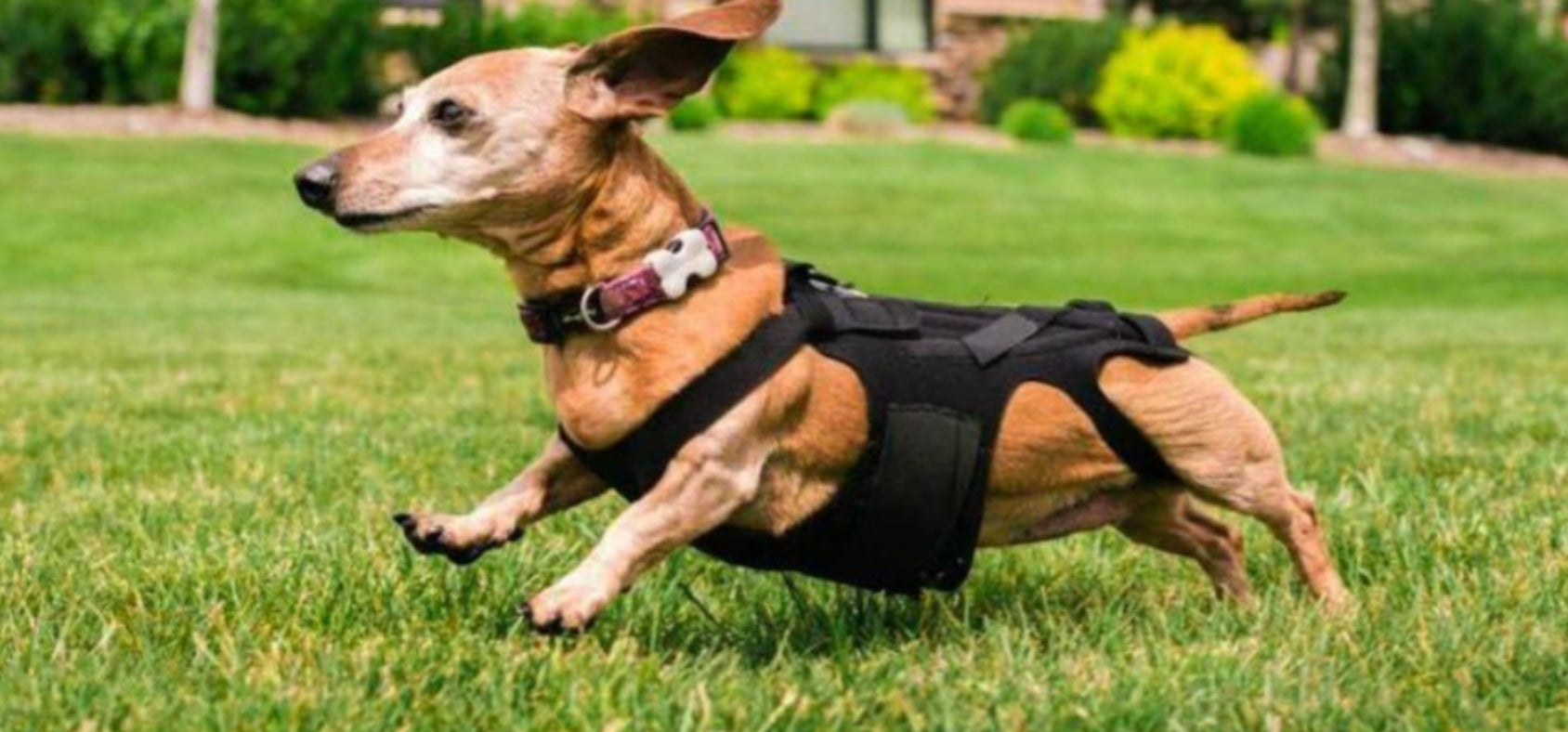01730 622544

What is IVDD and How Can I Help My Dog with IVDD?
Definition
Intervertebral disc disease in dogs (IVDD), sometimes referred to as a herniated, or slipped disc in dogs, refers to a syndrome of pain and neurological problems that accompany degeneration of one or more intervetebral discs. These disks are pillow-like pads that act as shock-absorbers between adjoining vertebrae - the bones that make up the backbone or spine. Intervertebral discs can become displaced, deteriorate, collapse, bulge out (protrude), rupture, or herniate in dogs as a result of gradual degeneration due to conformational abnormalities, obesity, genetics, repetitive trauma or other factors.

How IVDD Affects Dogs
Intervertebral disc disease (IVDD) can cause a number of symptoms in domestic dogs, ranging from signs of mild pain to partial or complete paralysis. Most cases fall somewhere in between these two extremes. The signs of dog IVDD can mimic those of acutely ruptured discs such as from trauma or otherwise, but the causes are very different. IVDD in dogs occurs more commonly in certain breeds but can occur in any breed or mix of breeds and in dogs of any age or gender. IVDD can lead to permanent nerve damage. Timely recognition of IVDD symptoms, and intervention, is extremely important.
Symptoms of IVDD
The observable signs of intervertebral disc disease can be quite variable. Owners of affected dogs may notice one or more of the following symptoms, which can be sudden, intermittent or gradual in onset:- Neck pain and stiffness (reluctance to move the neck and head)
- Lowered head stance
- Back pain and stiffness
- Yelping unexpectedly when touched or moving
- Abdominal tenderness or tenseness
- Arched back (hunched posture, called "thoracolumbar kyphosis")
- Sensitivity to touch (possible aggression)
- Sensitivity to movement
- Impaired, incomplete or inappropriate urination
- Lameness
- Dragging one or more legs when walking
- "Toeing over" or "knuckling over" when walking or standing
- Weakness
- Stiffness
- Stilted gait; tentative gait
- Reluctance to rise
- Tremors, trembling, shaking
- Lack of coordination ("ataxia")
- Abnormal reflexes
- Collapse
- Paralysis in one or more limbs
Owners often notice similar signs after their dog has engaged in strenuous physical activity or experienced acute physical trauma. An acutely ruptured disc can be caused in an otherwise normal dog by jumping off high places, jumping out of a car or off the bed of a pick-up truck, playing a rousing game of fetch or Frisbee, or leaping out of an owner's arms, among other activities. A healthy dog can also suffer acute-onset of disc damage when it has been hit by a car, attacked by another animal or experienced some other form of trauma. This type of acute traumatic injury is not the same as IVDD, although the symptoms can be very similar. IVDD in dogs involves a degenerative process and does not result merely from sudden trauma. However, sudden trauma can cause rupture or herniation of an intervertebral disc in a dog whose discs already are weakened by dog IVDD.
Dogs At Increased Risk
Intervertebral disc disease occurs primarily in middle-aged chondrodystrophic breeds (3 to 6 years). So IVDD in French Bulldogs and Dashshunds is not uncommon. When it occurs in non-chondrodystrophic breeds, they typically are older (8 to 10 years). Chondrodystrophy is a disorder of cartilage formation. Cartilage is a specialized, tough, gristly type of connective tissue that essentially provides a model for bone development and growth. In chondodystrophic breeds such as Dachshunds, Bulldogs and Bassett Hounds, chondrodystrophy is seen as characteristic angular limb deformities and abnormally short legs otherwise known as hereditary dwarfism. Other chondrodystrophic breeds include Beagles, Corgis, Cocker Spaniels, Pekingese, Shih-Tzus and Poodles. Non-chondrodystrophic breeds that are commonly affected by dog IVDD include German Shepherds, Labrador Retrievers and Doberman Pinschers. Obese dogs of predisposed breeds are especially likely to suffer from IVDD.
How Can I prevent IVDD in My Dog Or Help My IVDD Dog?
The best way to prevent dog IVDD if your dog is at risk is to restrict any unwanted movement. The Wiggleless Back Brace is a dog back brace for dog spine problems that can be used to support and stabilise the spinal column and restrict any unwanted movement, twisting or jumping which could cause injury to the spine or further damage any minor spinal injuries.

Treatment options for dog IVDD range from rest and conservative medical management to intervention with IVDD surgery. The exact therapeutic protocol will vary depending upon the severity of the disease. In acute cases, pain management and control of inflammation are the first priorities. Cage rest is needed to restrict any movement whether or not surgical intervention is undertaken.
The Wiggleless Back Brace is a dog back brace that's often used in these cases. It helps to keep the back straight and supported. Your dog will also need some pain management. We offer Winston's Pain Formula which is a very popular product offering natural and strong pain relief and anti-inflammatory, it can be used on top of any vet medication your dog is already taking. It is also recommended that any dogs with back or joint pain have a high quality and comfortable bed, this is particularly important for dogs on cage rest as they will be using their bed for long periods of time. We recommend the Balto Orthopaedic Memory Foam Bed, this is a very high quality and thick memory foam made in Italy and specifically designed for older dogs or dogs with joint or back pains.

Looking for help with your dog?
We can help find the right solution for your dog
Feel free to give us a call on 01730 622544
or email us at woof@zoomadog.co.uk






Leave a comment